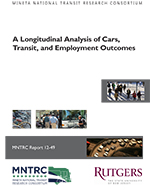Abstract:
Access to cars and transit can influence individuals’ ability to reach opportunities such as jobs, health care, and other important activities. While access to cars and public transit varies considerably across time, space, and across populations, most research portrays car access as a snapshot in time; some people have a car and others do not. But does this snapshot approach mask variation in car ownership over time? And how does access to particular types of transportation resources influence individuals’ economic outcomes?
The authors improve upon existing research by using panel data from 1999 to 2013 from the Panel Study of Income Dynamics (PSID) to examine levels of automobile access in groups that have variable access: poor families, immigrants, and people of color. They further employ two new national datasets of access to jobs using public transit. These datasets are used to examine the effect of transit and automobile access on income growth over time within families, controlling for a number of relevant variables.
The research found that for most families, being “carless” is a temporary condition. While 13% of families in the US are carless in any given year, only 5% of families are carless for all seven waves of data examined in the analysis. The research also found that poor families, immigrants, and people of color (particularly blacks) are considerably more likely to transition into and out car owner-ship frequently and are less likely to have a car in any survey year than are non-poor families, the US-born, and whites.
The research also found that improving automobile access is associated with a decreased probability of future unemployment and is associated with greater income gains. However, the analysis suggests that the costs of owning and maintaining a car may be greater than the income gains associated with in-creased car ownership. The relationship between public transit and improved economic outcomes is less clear. The research found that living in areas with access to high-quality public transportation has no relationship with future earnings. However, transit serves an important purpose in providing mobility for those who cannot or choose not to own a car.
Authors:
MICHAEL J. SMART, PH.D.
Dr. Michael Smart is an assistant professor at the Edward J. Bloustein School of Planning and Public Policy at Rutgers. His research interests include the influence of social and spatial phenomena on individuals’ transportation decisions, with a particular interest in built-environment effects on alternative modes of travel, such as biking and walking. Dr. Smart’s current research explores the ways in which social networks embedded in particular neighborhoods of affinity—such as immigrant neighborhoods and gay and lesbian neighborhoods—influence the activity patterns of those who live in those neighborhoods. His work has examined the extent to which immigrant neighborhoods across the country function as “cities-within-cities,” and developed novel techniques for describing the inward-or outward-focus of neighborhoods. He received his PhD from the Department of Urban Planning at UCLA in 2011, as well as a Master’s degree in planning from the University of Pennsylvania in 2006 and a Bachelor’s degree in German from Yale in 2000.
NICHOLAS J. KLEIN, PH.D.
Dr. Nicholas J. Klein is a research assistant professor in the Department of Community and Regional Planning at Temple University. His research focuses on questions of social equity in transportation planning, primarily by studying marginalized populations that use transit, walk, and bike at high rates. He holds a PhD in Urban Planning and Public Policy from the Edward J. Bloustein School at Rutgers University, a Master’s degree in urban spatial analytics from the University of Pennsylvania and a BS in operations research and industrial engineering from Cornell University. He also worked for several years as a transportation consultant, developing and implementing travel demand models.


